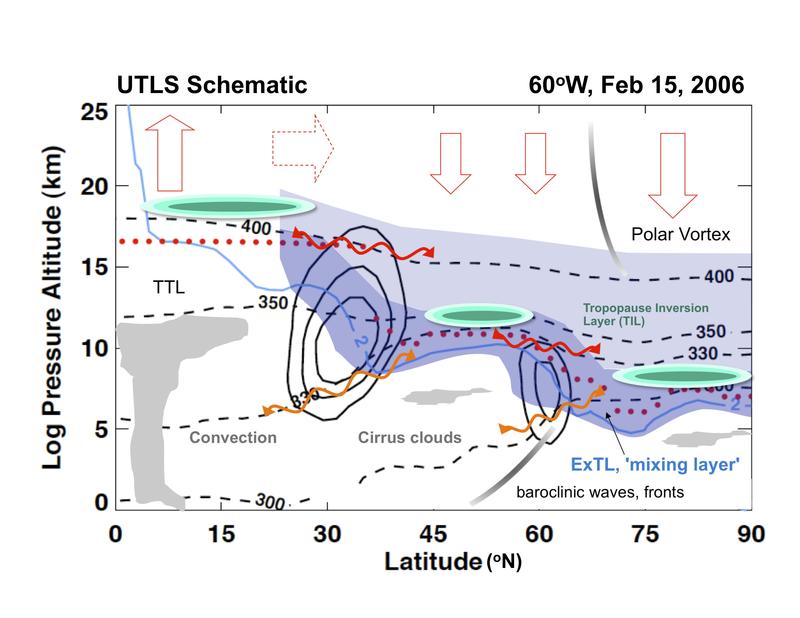Progress in Understanding Climate-Relevant Processes in the Upper Troposphere and Lower Stratosphere
The extratropical upper troposphere and lower stratosphere (Ex‐UTLS) is a transition region between the stratosphere and the troposphere. In this region, dynamics, chemistry, clouds and radiation are strongly coupled, which makes this region important for chemistry-climate interactions. Significant progress has been made in understanding the climate-relevant processes in this region during the last decade, assisted by a suite of new observational studies. The NCAR UTLS program directed field campaigns using the GV aircraft, and these campaigns played a significant role in these new studies. The new developments formed the highlight of a community workshop held at NCAR in 2009 and are captured in a recent review article [Gettelman et al., 2011].
The Ex‐UTLS includes the tropopause, a strong static stability gradient and dynamic barrier to transport. The barrier is reflected in tracer profiles. This region exhibits complex dynamical, radiative, and chemical characteristics that place stringent spatial and temporal requirements on observing and modeling systems. The Ex‐UTLS couples the stratosphere to the troposphere through chemical constituent transport (of, e.g., ozone), by dynamically linking the stratospheric circulation with tropospheric wave patterns, and via radiative processes tied to optically thick clouds and clear‐sky gradients of radiatively active gases. A comprehensive picture of the Ex‐UTLS brings together different definitions of the tropopause, focusing on observed dynamical and chemical structure and their coupling. This integral view recognizes that thermal gradients and dynamic barriers are necessarily linked, that these barriers inhibit mixing and give rise to specific trace gas distributions, and that there are radiative feedbacks that help maintain this structure. The impacts of 21st century anthropogenic changes to the atmosphere due to ozone recovery and climate change will be felt in the Ex‐UTLS.
Figure 1 shows the structure of the Ex-UTLS. The tropopause can be defined using either a thermal (lapse rate), dynamical (PV) or chemical (Ozone gradient) definition. But they are really tightly coupled: potential vorticity gradients in the vertical are determined by the static stability and hence the lapse rate, and these gradients then also create a transport gradient that gives rise to ozone and other tracer gradients.

Figure 1: Schematic snapshot of the extratropical UTLS using data from a Northern Hemisphere section along 60°W longitude on 15 February 2006. Wind contours (solid black lines 10 ms−1 interval), potential temperature surfaces (dashed black lines), thermal tropopause (red dots), and potential vorticity surface (2 PVU: light blue solid line). Illustrated schematically are the Ex‐UTLS (dark and light blue shading), ExTL (dark blue shading), clouds and fronts (gray shading), static stability contours in the TIL (green shading), quasi‐isentropic exchange (red wavy arrows), cross‐isentropic exchange (orange wavy arrows), and the Brewer‐Dobson Circulation (deep, red solid outline; shallow, dotted solid outline).
The Tropopause Inversion Layer is a region of high stability right around the tropopause at the base of the Ex-UTLS. It is a ubiquitous structure in the Ex-UTLS region, and exists in the tropics and extratropics. It is strongest in the summer hemisphere, indicating a possible role of radiative processes in maintaining it, particularly in polar regions. These radiative processes are due to ozone and water vapor gradients at the tropopause, which links transport and the tropopause structure. The inversion layer is part of the Extratopical Transition Layer (Ex-TL), a region extending from about the lapse rate tropopause to several km above it. This region features strong tracer gradients, and varies in size and composition with near tropopause mixing processes. It can be defined in several ways, but is a robust feature of the Ex-UTLS, indicating the strength and depth of transport processes.
The Ex-UTLS region has been evolving over the last 50 years, and is expected to continue to evolve over the next century, due to anthropogenic changes to the atmosphere. Ex-UTLS Ozone has changed dramatically due to the decline and now nascent recovery of stratospheric ozone. This may alter the structure of the UTLS. Radiative forcing due to greenhouse gases has led to an increase in tropopause height, and through complex wave dynamics, to alterations of the sub-tropical and tropospheric mid-latitude jets and storm tracks. These trends may continue, and reveal the important role of the Ex-UTLS in global climate.
Reference: Gettelman, A., P. Hoor, L. L. Pan, W. J. Randel , M. I. Hegglin and T. Birner, The Extratropical Upper Troposphere and Lower Stratosphere Rev. Geophys, 49, RG3003, doi:10.1029/2011RG000355
